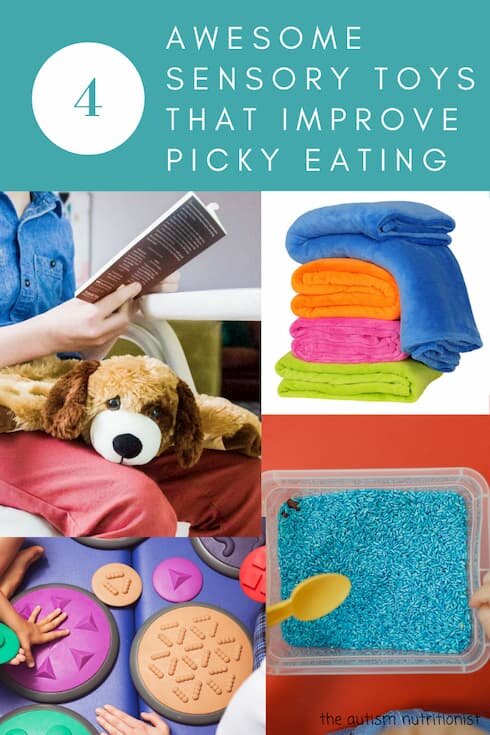
These four fun ways to improve picky eating focus on making eating more comfortable from a sensory perspective.
Most of the extreme picky eaters I work with – whether they’re on the autism spectrum or not – experience some degree of sensory impairment that contributes to what and how they eat.
This means children can prefer certain tastes and textures or maybe they are sensitive to the smells and sounds in the environment.
My approach to improving extreme picky eating focuses on accommodating a child’s sensory needs. For example, I recommend adapting foods to better fit a child’s sensory preferences and paying attention to triggers in the environment that might be making it more difficult for them to eat with others or sit at the table for an entire meal.
While I always recommend consulting with your occupational therapist or another professional who specializes in sensory processing disorder, there are some accessible sensory tools that can significantly improve eating behavior. These make eating more comfortable for your child and can improve their stamina and comfort at the table, increasing their willingness to eat. These are particularly great for children who have a hard time sitting at the table to eat.
Check out more of my favorite products, toys, and tools to improve picky eating:
-
10 Things Worth Buying to Significantly Improve your Child’s Relationship with Food
-
7 Picky Eating Products Under $10 that Parents Are Obsessed With
4 Awesome Sensory Tools to Improve Picky Eating
Kids Weighted Blanket
A tired child doesn’t function at their best. Which means a child who struggles to eat will only have greater trouble when they’re tired. I love weighted blankets and this one is designed specifically for kids with sensory needs. In addition to being super cozy and regulating, they come in a variety of fun colors.
Weighted Lap Pad
If your child struggles to sit at the table, I first recommend checking their chair to ensure that it is comfortable and supportive. If you’ve checked all of those boxes and they’re still fidgety and uncomfortable, consider investing in a weighted lap pad. Weighted lap pads provide pressure that soothes your child and leads to more pleasant, calmer mealtimes. Try a basic pad to go with the weighted blanket or this fun puppy dog one.
Sandbox Sensory Bin
Playing with gritty textures can desensitize the tactile system helping children with sensory issues feel more comfortable with food textures. If your picky eater doesn’t like to get messy or is particular about the textures they eat, incorporate this sort of sensory play using a sensory bin on a regular basis. You’ll be surprised how hands on activities with non-food textures will eventually improve their reception of new food textures.
You can make your own sensory bin or head to the local sandbox. I’m also a big fan of this dinosaur themed box and a Montessori-style alternative.
Wiggle Seat
Maybe you’ve unsuccessfully tried a weighted lap pad to help your child stay seated comfortably at the table. Instead of overriding your child’s urge to move at meals, try to harness it. A wiggle seat can be a simple accommodation. It is a textured, inflatable disc that your child can sit on. It allows for subtle movement that can be regulating and can improve endurance during mealtimes.
Recap
Most picky eaters I know struggle with some sensory processing impairment. I like to tailor foods to accommodate a child’s sensory needs, but that doesn’t always address other sensory issues that can interfere with eating. The tools above can help soothe a child who is uncomfortable eating and make sitting at the table and trying new foods easier.



0 Comments